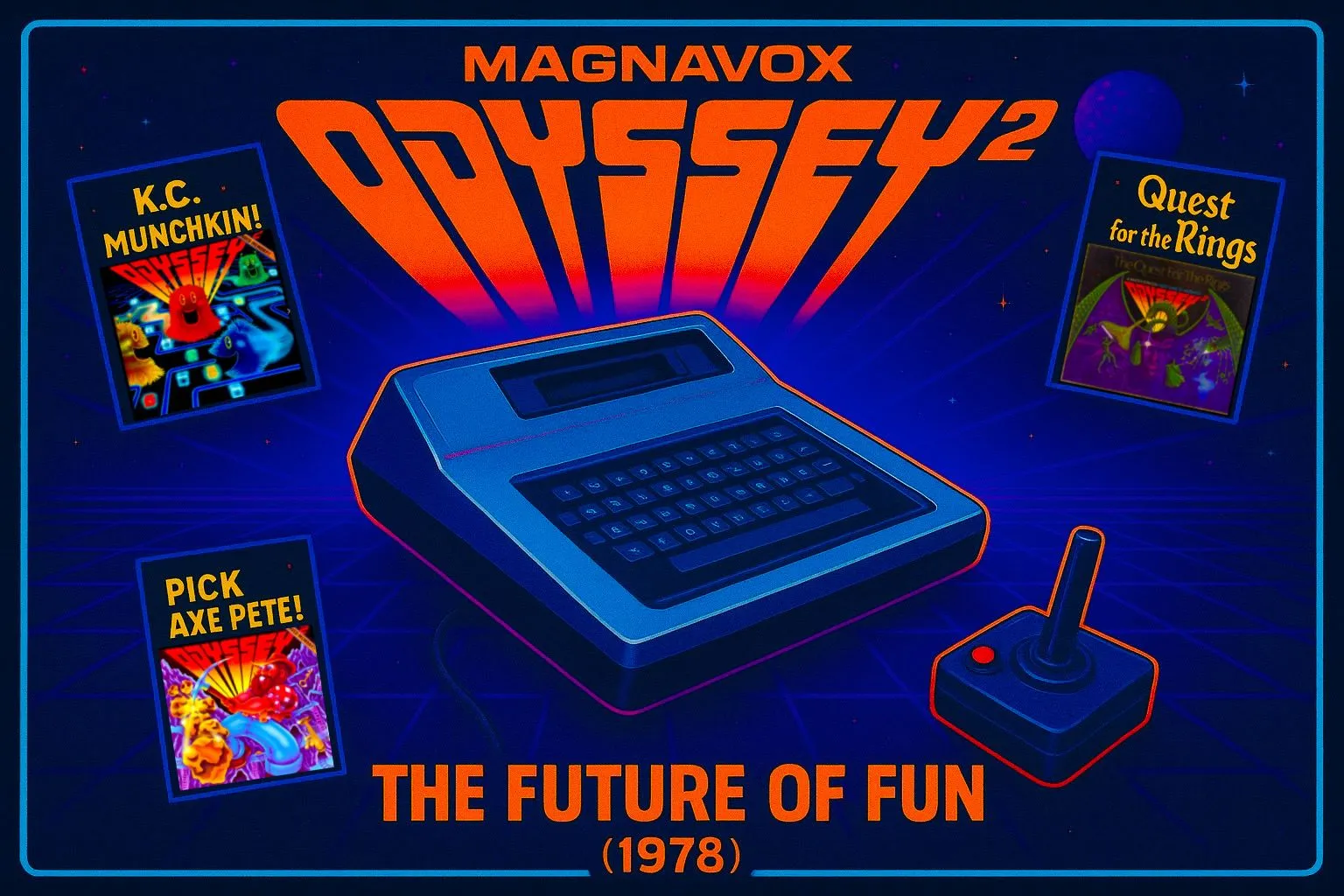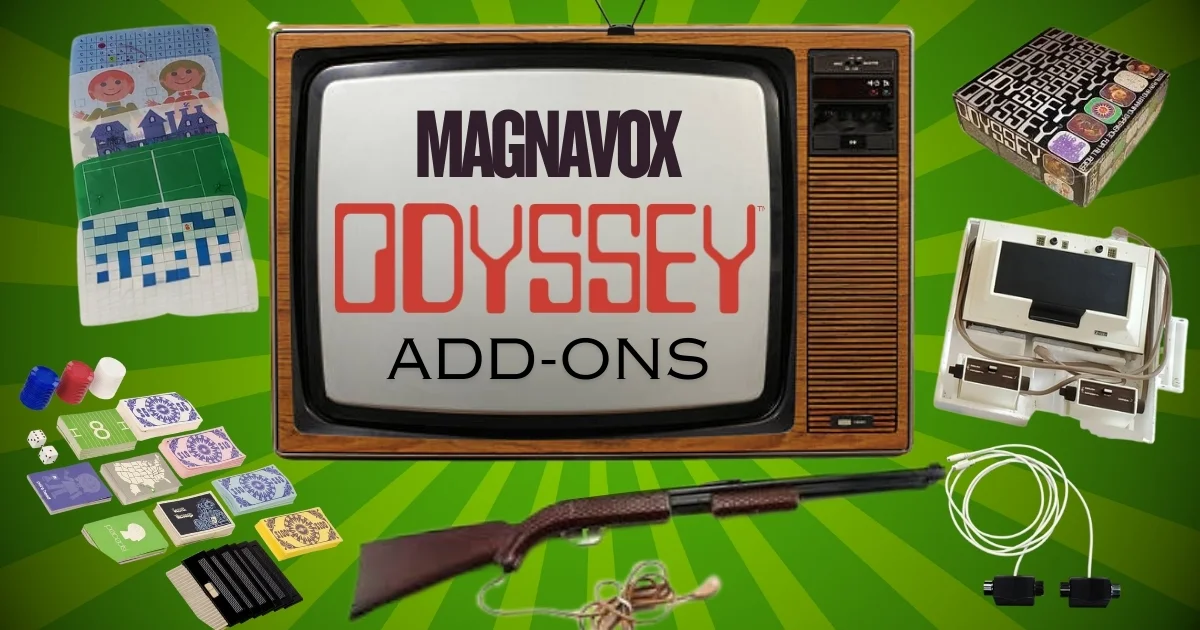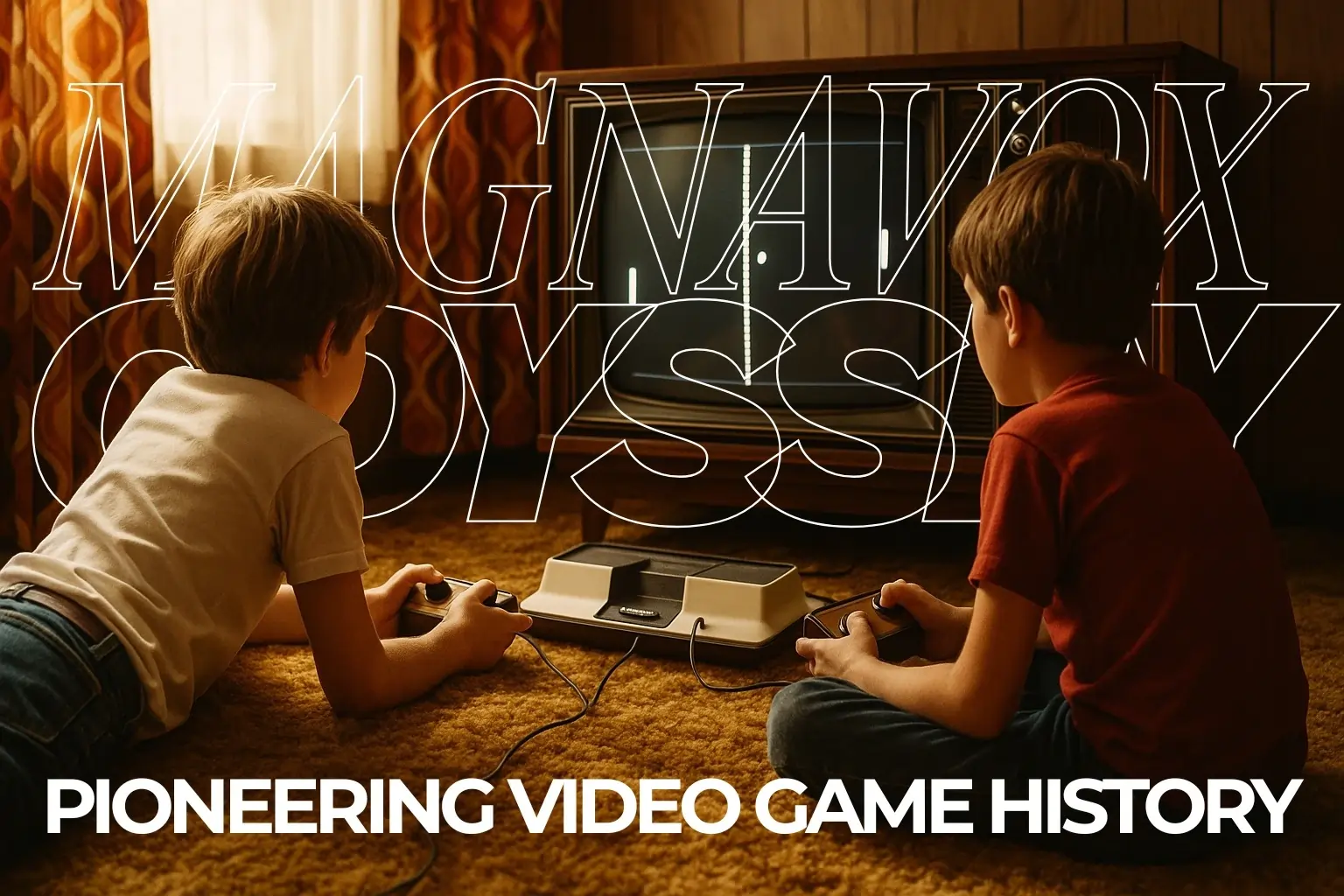Magnavox Odyssey 2: The Talking Keyboard Console Explained
When you hear the name Magnavox Odyssey, chances are you immediately think of the world’s first video game console. Released in 1972, the original Odyssey secured its place in history as the pioneer of home gaming. But what about its successor?
Enter the Magnavox Odyssey 2 — a console released in 1978 that doesn’t carry the same fame as its older sibling but carved out its own fascinating legacy. Known in Europe as the Philips Videopac G7000, the Odyssey 2 stood out with a built-in keyboard, a voice module add-on, and hybrid video/board games that were ahead of their time. Though overshadowed by giants like the Atari 2600 and Mattel Intellivision, the Odyssey 2 is remembered today as one of the most inventive systems of its era.
In this article, we’ll dive into the history, features, games, and cultural impact of the Magnavox Odyssey 2 Console, exploring why this “forgotten console” deserves a place in gaming history.
What Was the Magnavox Odyssey 2?
The Magnavox Odyssey 2 (often stylized as Odyssey² or Odyssey 2) was a second-generation video game console, released in 1978 by Magnavox in North America and Philips in Europe. Unlike the original Odyssey, which used cards to select games, the Odyssey 2 featured programmable ROM cartridges — a huge step forward.
It wasn’t just marketed as a gaming machine. Magnavox and Philips positioned it as a hybrid between a video game console and a home computer, with a built-in alphanumeric keyboard that encouraged educational games and even simple programming.
Known under different names worldwide:
- Philips Videopac G7000 (Europe)
- Philips Odyssey (Brazil/Peru)
- Odyssey 2 (United States and Japan)
This rebranding helped the console reach diverse audiences, particularly in Europe and South America, where it fared much better than in the U.S.
Key Features That Made the Magnavox Odyssey 2 Unique
While Atari and Intellivision focused heavily on arcade-style gameplay, the Odyssey 2 took a different path. Here’s what made it stand out:
- The Keyboard Console
The Odyssey 2 was the first home video game console with a built-in keyboard. This wasn’t a decorative feature — the keyboard allowed for educational software, word games, and limited programming. Parents in the late 70’s were promised not just fun, but also “edutainment”.
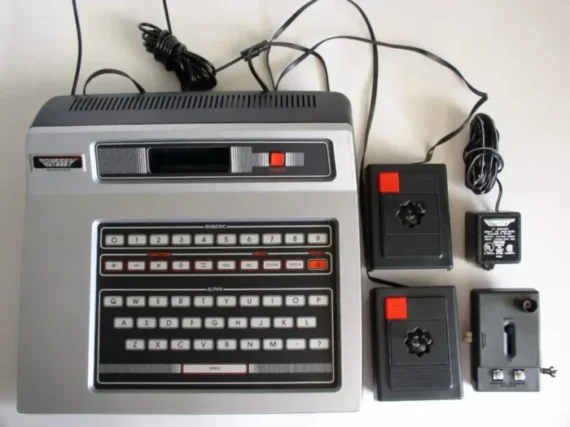
In an era when personal computers were expensive and intimidating, the Odyssey 2 was marketed as a family-friendly alternative that combined learning and play.
-
The Voice Module – The First Talking Console
One of the Odyssey 2’s most remarkable innovations was the Voice Module, released in 1979. This expansion allowed certain games to feature speech synthesis, with phrases and sound effects coming from a speaker on the module itself.
At the time, this was mind-blowing. Imagine your console talking to you in 1979 — it was futuristic. Though limited to a handful of games, the Voice Module made the Odyssey 2 the first console to offer voice interaction, a precursor to features we now take for granted in modern gaming.
-
Hybrid Board + Video Games
Magnavox doubled down on creativity by releasing hybrid games that combined physical board game pieces with video gameplay. Titles like The Great Wall Street Fortune Hunt and Quest for the Rings included physical maps, cards, and tokens, bridging the gap between traditional board games and digital entertainment.
This concept foreshadowed modern trends in mixed-reality gaming, where physical and digital play blend together.
-
Controllers
The Odyssey 2 shipped with two digital joysticks. Early models had controllers permanently attached, but later versions switched to detachable cables. While not as advanced as Intellivision’s keypad controllers, they were durable and easy to use for quick play sessions.
The Odyssey 2 Game Library
The Odyssey 2 had a surprisingly diverse library of around 60 officially released titles. While not as massive as the Atari 2600’s, the catalog reflected the console’s experimental spirit.
Standout Games:
- K.C. Munchkin! (1981) – Perhaps the most famous Odyssey 2 title, this Pac-Man clone sparked a legal battle when Atari sued Magnavox for copyright infringement. The game was pulled from shelves but remains a collector’s gem today.
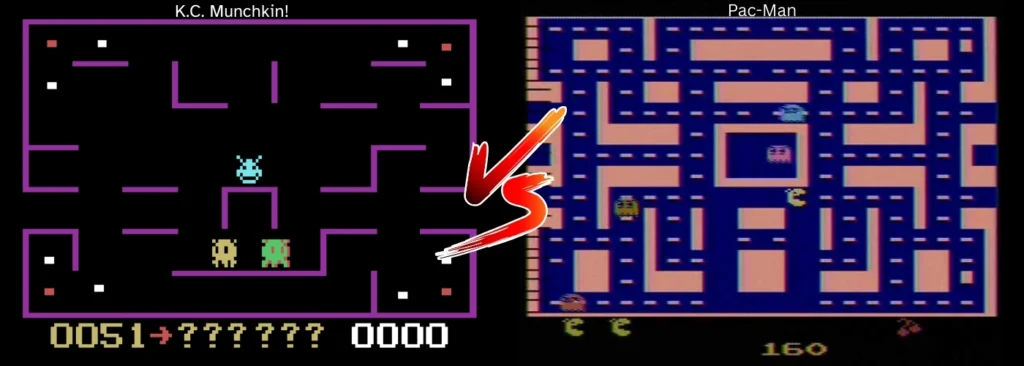
Magnavox Odyssey 2’s K.C. Munchkin vs Atari 2600’s Pac-Man - Pick Axe Pete! (1982) – A proto-platformer where players navigate caves, break walls, and avoid boulders. It’s often compared to Donkey Kong.
- Quest for the Rings (1981) – A legendary hybrid game blending a physical board with on-screen adventure elements. Widely regarded as one of the console’s best experiences.
- The Great Wall Street Fortune Hunt (1982) – A finance-themed game that combined the console with stock market simulation and a physical board.
- Attack of the Timelord! (1982) – A fast-paced space shooter that pushed the system’s graphical limits.
The mix of arcade clones, original concepts, and hybrid board games made the Odyssey 2’s library unique. While not as broad as Atari’s, it carried a charm that resonated with players looking for something different.
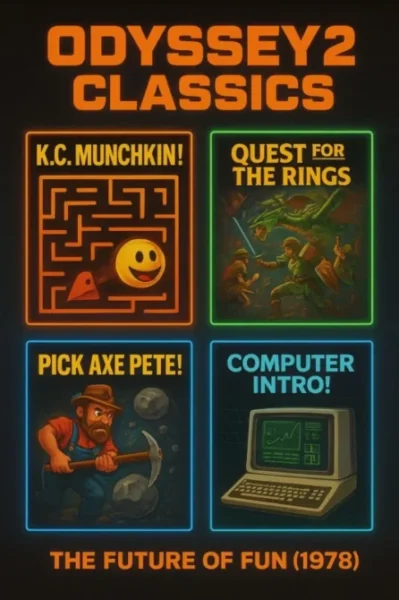
The Magnavox Odyssey 2 vs Its Rivals
The late 70’s and early 80’s were the golden age of second-generation consoles. To understand the Odyssey 2’s place in history, we need to compare it to its biggest competitors:
- Atari 2600: Launched in 1977, Atari’s system quickly became the market leader with hundreds of third-party titles and strong arcade conversions. It overshadowed almost every rival in the U.S.
- Intellivision: Released in 1979 by Mattel, it positioned itself as the “superior” console with better graphics and more complex controllers.
- Odyssey 2: Released between these two, it was often the “forgotten third option.” While it didn’t match Atari’s game library or Intellivision’s marketing, it carved out a niche with its keyboard and hybrid approach.
In sales, the Odyssey 2 managed to ship around 2 million units worldwide, respectable but far from Atari’s dominance.
Success in Europe & Brazil
While the Odyssey 2 struggled in North America, it found significant success abroad.
- In Europe, marketed as the Philips Videopac G7000, it enjoyed strong distribution thanks to Philips’ established electronics network.
- In Brazil, import restrictions meant local manufacturing was key — and Philips produced the Odyssey 2 locally, making it more accessible than foreign competitors. As a result, it became one of Brazil’s most popular consoles of the early 80s.
This regional success kept the Odyssey 2 alive until 1984, even as the North American video game market began to collapse.
Legacy of the Magnavox Odyssey 2
So why should we remember the Odyssey 2 today? After all, it wasn’t the first console (like the original Odyssey) nor the best-selling (like Atari). Its significance lies in innovation:
- It was the first console with a built-in keyboard, blurring the line between games and computing.
- It introduced speech synthesis to gaming with the Voice Module.
- It experimented with hybrid board/digital games, foreshadowing modern cross-media play.
- It highlighted the idea that consoles could be educational as well as entertaining.
For collectors and retro gaming enthusiasts, the Odyssey 2 represents a fascinating “what if” moment in gaming history — what if more families had embraced it as an educational tool, or if its hybrid games had taken off?
Today, Odyssey 2 consoles and cartridges are prized by retro collectors, especially rare games like K.C. Munchkin! and Quest for the Rings.
Conclusion
The Magnavox Odyssey 2 may not have the fame of its predecessor, but it left a lasting imprint on gaming history. As the first talking console, the keyboard console, and a champion of hybrid gameplay, it was a bold experiment in an industry still trying to define itself.
While Atari and Intellivision battled for dominance in the United States, the Odyssey 2 quietly built loyal fanbases in Europe and Brazil. Its innovative features paved the way for ideas that would reappear in future consoles — from keyboards to voice interaction to mixed-reality play.
In the grand story of gaming, the Odyssey 2 is a reminder that not every console needs to dominate the market to be significant. Sometimes, the most interesting stories come from the forgotten underdogs.
FAQs
Q: When did the Magnavox Odyssey 2 come out?
Ans: The Magnavox Odyssey 2 was released in the Fall of 1978.
Q: When was the Magnavox Odyssey 2 discontinued?
Ans: The Magnavox Odyssey 2 was discontinued in March 1984.
Q: How much did the Magnavox Odyssey 2 cost?
Ans: $179 in 1978 (equivalent to $856 in 2025).

